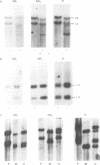Abstract
Thirty-one females with incontinentia pigmenti (IP), 42 controls, and 11 females from four families segregating for X linked lymphoproliferative disease (XLP) were studied for evidence of skewed X inactivation by analysis of methylation at sites in the HPRT, PGK, and M27 beta (DXS255) regions of the X chromosome. Extensive skewing of X inactivation was present in blood from 4/42 (9.5%) control females and 11/31 (35%) of those with IP. This frequency of skewed inactivation was seen in both familial and sporadic cases of IP. Analysis of inactivation in mother/daughter pairs, both affected and control subjects, showed no familial consistency of pattern, arguing against specific mutations being associated with particular patterns of inactivation. In the only informative family where both mother and daughter were affected by IP and showed skewed inactivation, the IP mutation was on the active X chromosome. This argues against cell selection during early embryogenesis being the explanation for the skewed inactivation observed. These data confirm that skewed inactivation of one X is observed in lymphocytes from a significant minority of normal females, and is seen with raised frequency in IP heterozygotes. It is not, however, a universally observed phenomenon, and the relationship of X inactivity to the IP mutation appears to be complex. In the case of XLP, though skewed X inactivation patterns are seen in most disease carriers, the frequency with which this phenomenon occurs in normal females renders it an unreliable diagnostic marker for XLP carriers.
Full text
PDF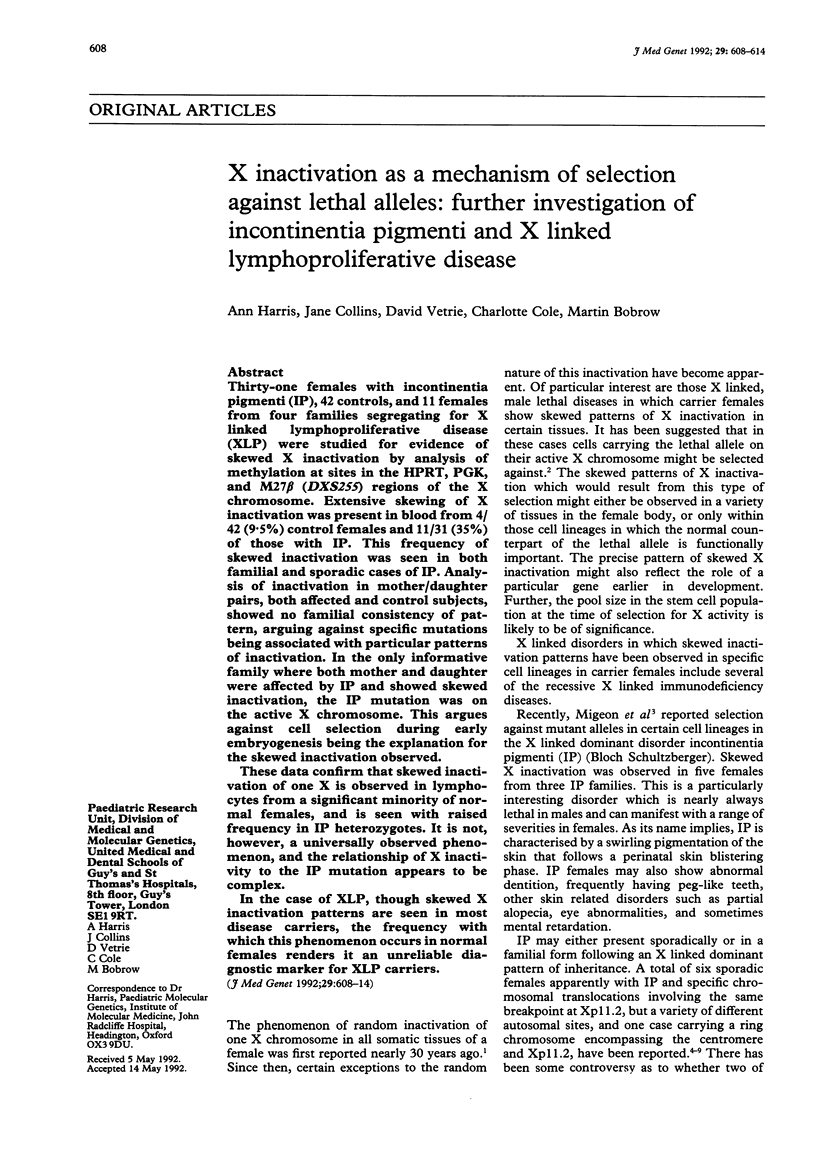

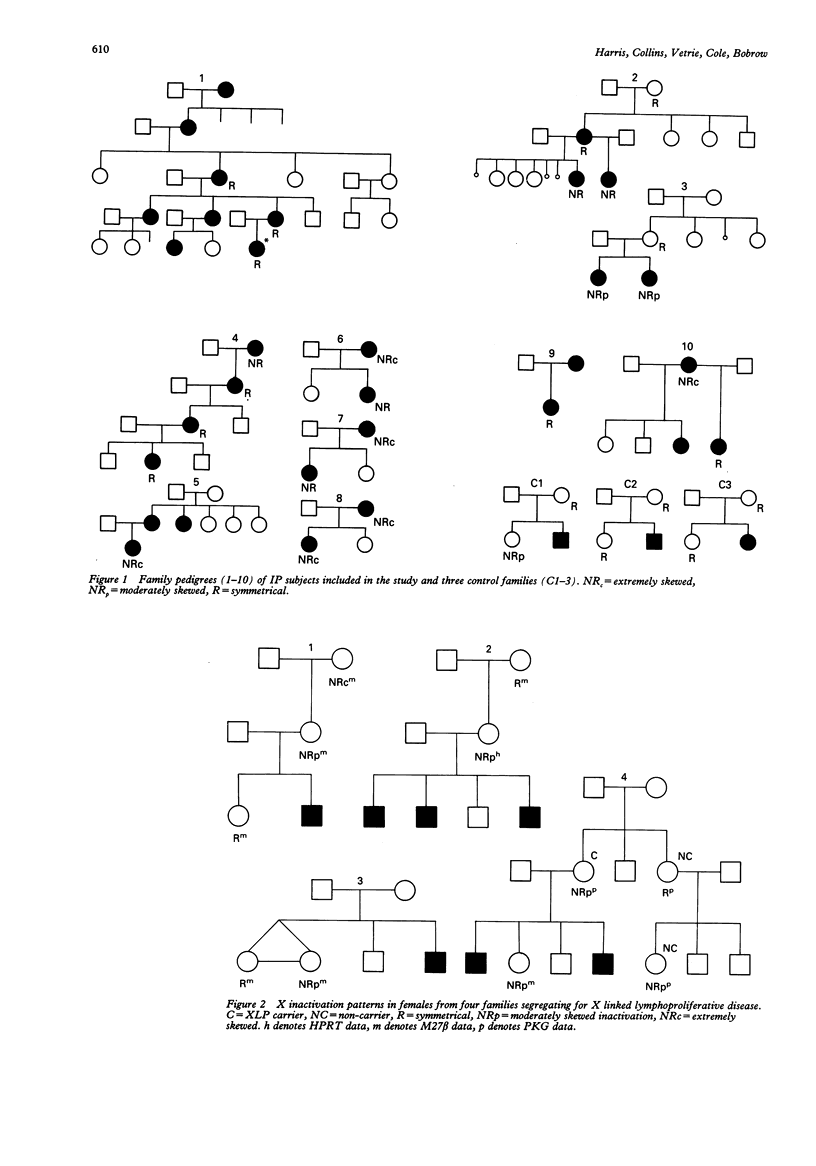
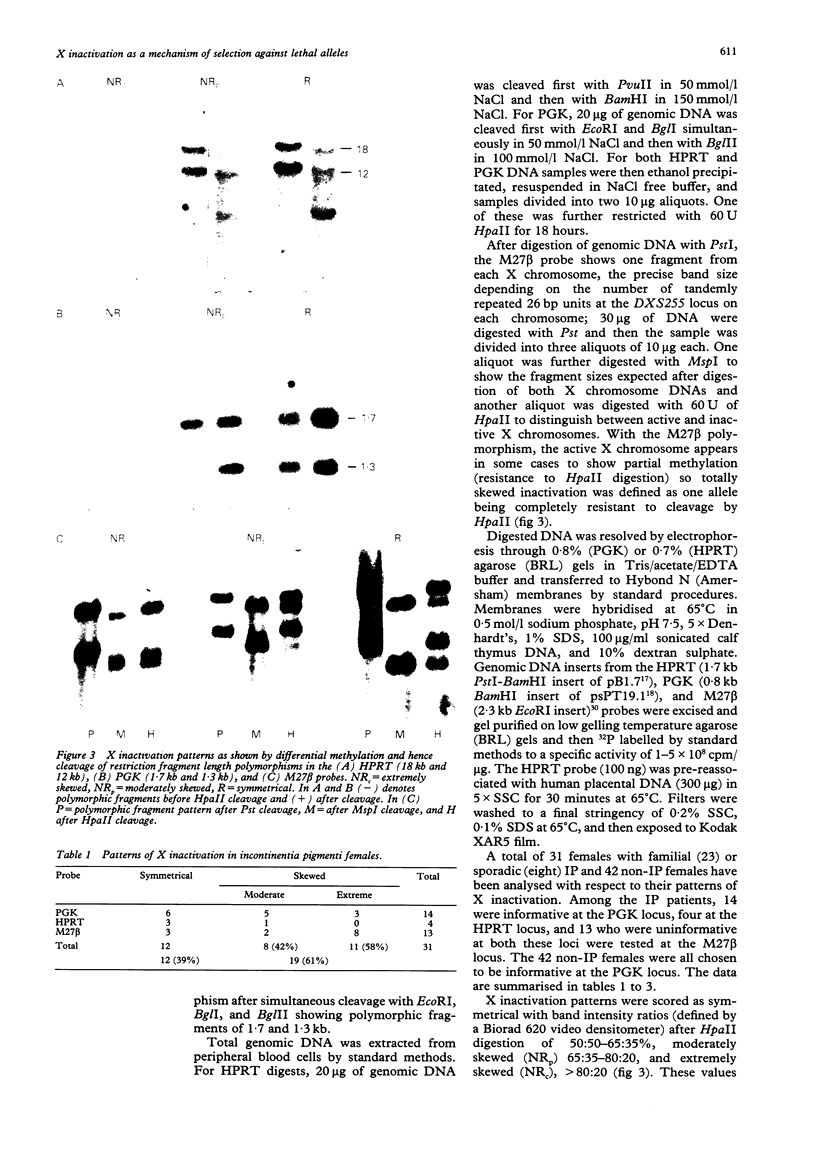
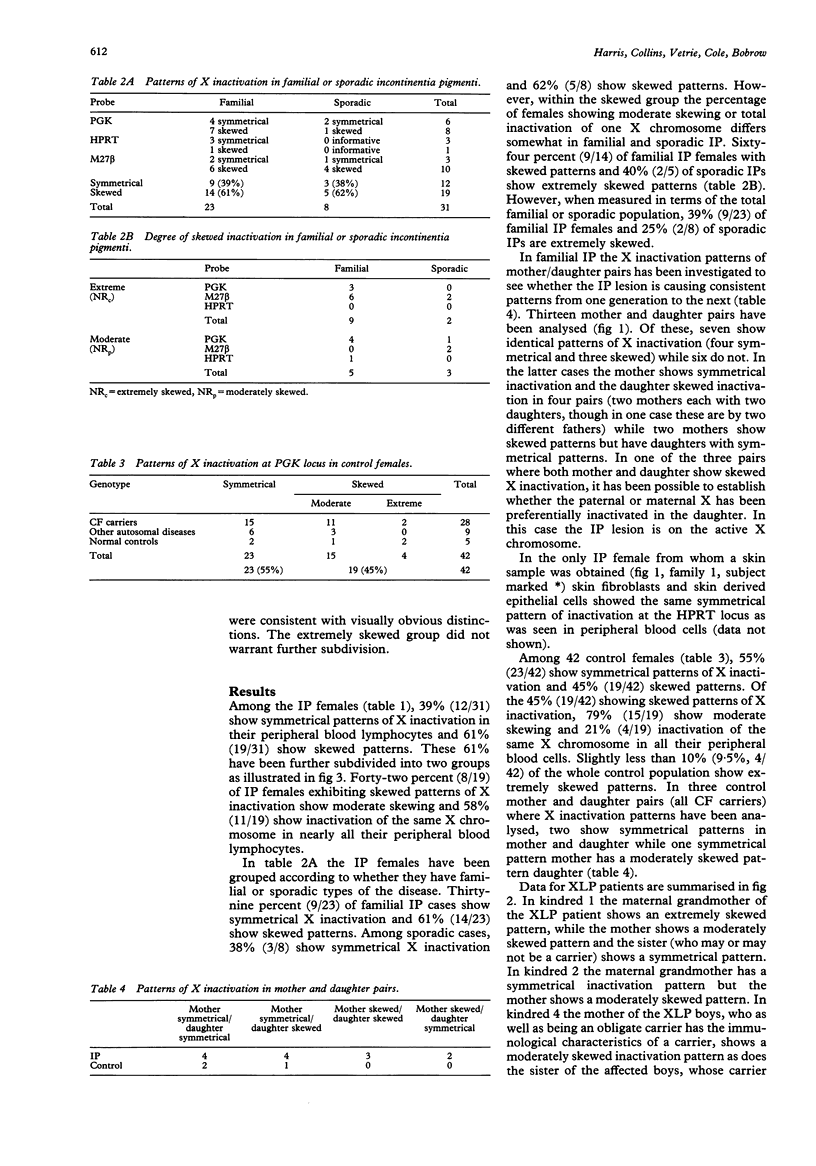
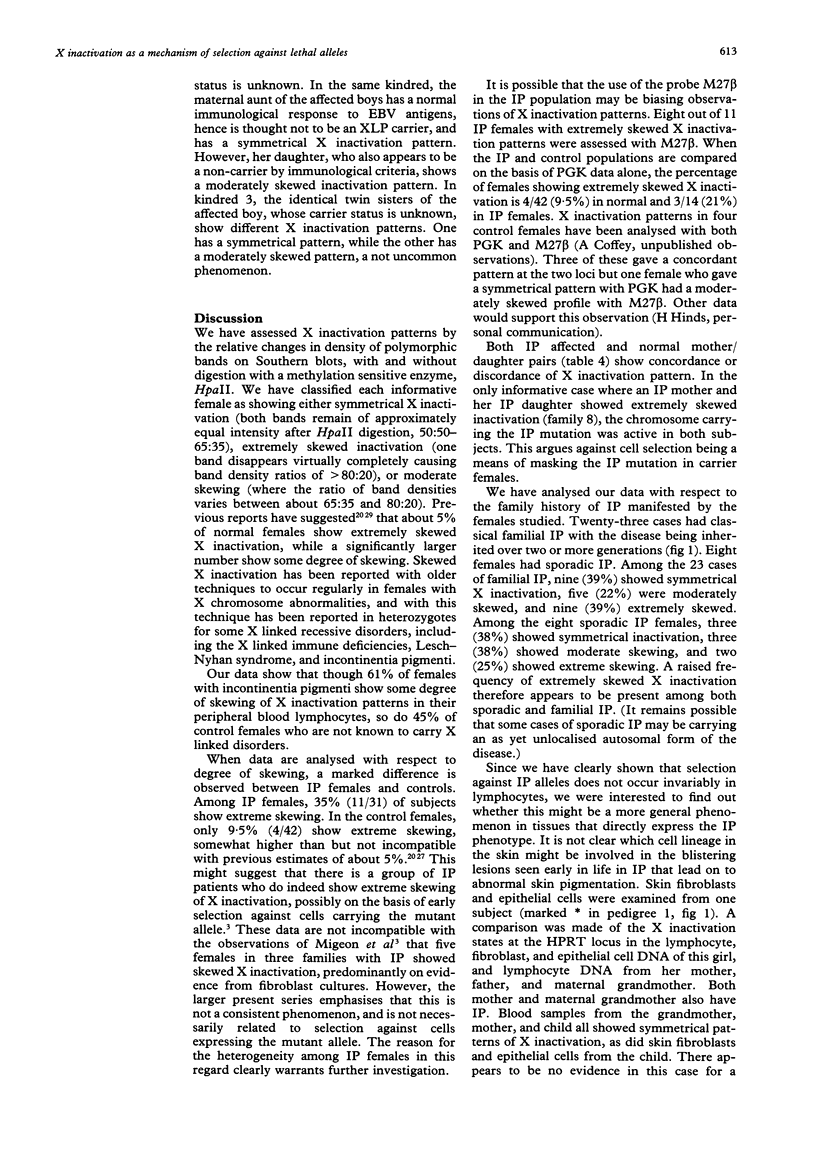

Images in this article
Selected References
These references are in PubMed. This may not be the complete list of references from this article.
- Abrahamson G., Fraser N. J., Boyd J., Craig I., Wainscoat J. S. A highly informative X-chromosome probe, M27 beta, can be used for the determination of tumour clonality. Br J Haematol. 1990 Mar;74(3):371–372. doi: 10.1111/j.1365-2141.1990.tb02601.x. [DOI] [PubMed] [Google Scholar]
- Ando I., Morgan G., Levinsky R. J., Crawford D. H. A family study of the X-linked lymphoproliferative syndrome: evidence for a B cell defect contributing to the immunodeficiency. Clin Exp Immunol. 1986 Feb;63(2):271–279. [PMC free article] [PubMed] [Google Scholar]
- Bernstein R., Dawson B., Kohl R., Jenkins T. X;15 translocation in a retarded girl: X inactivation pattern and attempt to localise the hexosaminidase A and other loci. J Med Genet. 1979 Aug;16(4):254–262. doi: 10.1136/jmg.16.4.254. [DOI] [PMC free article] [PubMed] [Google Scholar]
- Brown R. M., Fraser N. J., Brown G. K. Differential methylation of the hypervariable locus DXS255 on active and inactive X chromosomes correlates with the expression of a human X-linked gene. Genomics. 1990 Jun;7(2):215–221. doi: 10.1016/0888-7543(90)90543-4. [DOI] [PubMed] [Google Scholar]
- Brown R. M., Fraser N. J., Brown G. K. Differential methylation of the hypervariable locus DXS255 on active and inactive X chromosomes correlates with the expression of a human X-linked gene. Genomics. 1990 Jun;7(2):215–221. doi: 10.1016/0888-7543(90)90543-4. [DOI] [PubMed] [Google Scholar]
- Cannizzaro L. A., Hecht F. Gene for incontinentia pigmenti maps to band Xp11 with an (X;10) (p11;q22) translocation. Clin Genet. 1987 Jul;32(1):66–69. doi: 10.1111/j.1399-0004.1987.tb03326.x. [DOI] [PubMed] [Google Scholar]
- Fearon E. R., Kohn D. B., Winkelstein J. A., Vogelstein B., Blaese R. M. Carrier detection in the Wiskott Aldrich syndrome. Blood. 1988 Nov;72(5):1735–1739. [PubMed] [Google Scholar]
- Fraser N. J., Boyd Y., Brownlee G. G., Craig I. W. Multi-allelic RFLP for M27 beta, an anonymous single copy genomic clone at Xp11.3-Xcen [HGM9 provisional no. DXS255]. Nucleic Acids Res. 1987 Nov 25;15(22):9616–9616. doi: 10.1093/nar/15.22.9616. [DOI] [PMC free article] [PubMed] [Google Scholar]
- Gilgenkrantz S., Tridon P., Pinel-Briquel N., Beurey J., Weber M. Translocation (X;9)(p11;q34) in a girl with incontinentia pigmenti (IP): implications for the regional assignment of the IP locus to Xp11? Ann Genet. 1985;28(2):90–92. [PubMed] [Google Scholar]
- Greer W. L., Kwong P. C., Peacocke M., Ip P., Rubin L. A., Siminovitch K. A. X-chromosome inactivation in the Wiskott-Aldrich syndrome: a marker for detection of the carrier state and identification of cell lineages expressing the gene defect. Genomics. 1989 Jan;4(1):60–67. doi: 10.1016/0888-7543(89)90315-7. [DOI] [PubMed] [Google Scholar]
- Harris A., Coleman L. Establishment of a tissue culture system for epithelial cells derived from human pancreas: a model for the study of cystic fibrosis. J Cell Sci. 1987 Jun;87(Pt 5):695–703. doi: 10.1242/jcs.87.5.695. [DOI] [PubMed] [Google Scholar]
- Harris A., Docherty Z. X-linked lymphoproliferative disease: a karyotype analysis. Cytogenet Cell Genet. 1988;47(1-2):92–94. doi: 10.1159/000132516. [DOI] [PubMed] [Google Scholar]
- Harris A., Lankester S., Haan E., Beres J., Hulten M., Szollar J., Souttier L., Bobrow M. The gene for incontinentia pigmenti: failure of linkage studies using DNA probes to confirm cytogenetic localization. Clin Genet. 1988 Jul;34(1):1–6. doi: 10.1111/j.1399-0004.1988.tb02607.x. [DOI] [PubMed] [Google Scholar]
- Harris A., Lenoir G. M., Lankester S. A. X-linked lymphoproliferative disease: linkage studies using DNA probes. Clin Genet. 1988 Mar;33(3):162–168. doi: 10.1111/j.1399-0004.1988.tb03432.x. [DOI] [PubMed] [Google Scholar]
- Hodgson S. V., Neville B., Jones R. W., Fear C., Bobrow M. Two cases of X/autosome translocation in females with incontinentia pigmenti. Hum Genet. 1985;71(3):231–234. doi: 10.1007/BF00284581. [DOI] [PubMed] [Google Scholar]
- Jolly D. J., Esty A. C., Bernard H. U., Friedmann T. Isolation of a genomic clone partially encoding human hypoxanthine phosphoribosyltransferase. Proc Natl Acad Sci U S A. 1982 Aug;79(16):5038–5041. doi: 10.1073/pnas.79.16.5038. [DOI] [PMC free article] [PubMed] [Google Scholar]
- Kajii T., Tsukahara M., Fukushima Y., Hata A., Matsuo K., Kuroki Y. Translocation (X;13)(p11.21;q12.3) in a girl with incontinentia pigmenti and bilateral retinoblastoma. Ann Genet. 1985;28(4):219–223. [PubMed] [Google Scholar]
- Keith D. H., Singer-Sam J., Riggs A. D. Active X chromosome DNA is unmethylated at eight CCGG sites clustered in a guanine-plus-cytosine-rich island at the 5' end of the gene for phosphoglycerate kinase. Mol Cell Biol. 1986 Nov;6(11):4122–4125. doi: 10.1128/mcb.6.11.4122. [DOI] [PMC free article] [PubMed] [Google Scholar]
- Lyon M. F. Evolution of X-chromosome inactivation in mammals. Nature. 1974 Aug 23;250(5468):651–653. doi: 10.1038/250651a0. [DOI] [PubMed] [Google Scholar]
- Migeon B. R., Axelman J., Jan de Beur S., Valle D., Mitchell G. A., Rosenbaum K. N. Selection against lethal alleles in females heterozygous for incontinentia pigmenti. Am J Hum Genet. 1989 Jan;44(1):100–106. [PMC free article] [PubMed] [Google Scholar]
- Migeon B. R., Axelman J., Stetten G. Clonal evolution in human lymphoblast cultures. Am J Hum Genet. 1988 May;42(5):742–747. [PMC free article] [PubMed] [Google Scholar]
- Migeon B. R. Selection and cell communication as determinants of female phenotype. Basic Life Sci. 1978;12:417–432. doi: 10.1007/978-1-4684-3390-6_28. [DOI] [PubMed] [Google Scholar]
- Purtilo D. T., Yang J. P., Allegra S., DeFlorio D., Hutt L. M., Soltani M., Soltani M., Vawter G. Hematopathology and Pathogenesis of the X-linked recessive lymphoproliferative syndrome. Am J Med. 1977 Feb;62(2):225–233. doi: 10.1016/0002-9343(77)90318-7. [DOI] [PubMed] [Google Scholar]
- Sefiani A., Abel L., Heuertz S., Sinnett D., Lavergne L., Labuda D., Hors-Cayla M. C. The gene for incontinentia pigmenti is assigned to Xq28. Genomics. 1989 Apr;4(3):427–429. doi: 10.1016/0888-7543(89)90350-9. [DOI] [PubMed] [Google Scholar]
- Sefiani A., Sinnett D., Abel L., Szpiro-Tapia S., Heuertz S., Craig I., Fraser N., Kruse T. A., Frydman M., Peter M. O. Linkage studies do not confirm the cytogenetic location of incontinentia pigmenti on Xp11. Hum Genet. 1988 Nov;80(3):282–286. doi: 10.1007/BF01790098. [DOI] [PubMed] [Google Scholar]
- Vogelstein B., Fearon E. R., Hamilton S. R., Feinberg A. P. Use of restriction fragment length polymorphisms to determine the clonal origin of human tumors. Science. 1985 Feb 8;227(4687):642–645. doi: 10.1126/science.2982210. [DOI] [PubMed] [Google Scholar]
- Vogelstein B., Fearon E. R., Hamilton S. R., Preisinger A. C., Willard H. F., Michelson A. M., Riggs A. D., Orkin S. H. Clonal analysis using recombinant DNA probes from the X-chromosome. Cancer Res. 1987 Sep 15;47(18):4806–4813. [PubMed] [Google Scholar]
- Wolf S. F., Jolly D. J., Lunnen K. D., Friedmann T., Migeon B. R. Methylation of the hypoxanthine phosphoribosyltransferase locus on the human X chromosome: implications for X-chromosome inactivation. Proc Natl Acad Sci U S A. 1984 May;81(9):2806–2810. doi: 10.1073/pnas.81.9.2806. [DOI] [PMC free article] [PubMed] [Google Scholar]
- de Grouchy J., Turleau C., Doussau de Bazignan M., Maroteaux P., Thibaud D. Incontinentia pigmenti (IP) and r(X). Tentative mapping of the IP locus to the X juxtacentromeric region. Ann Genet. 1985;28(2):86–89. [PubMed] [Google Scholar]



